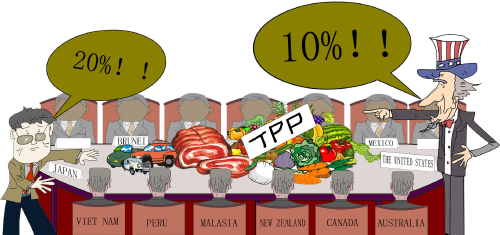 |
|
(LI SHIGONG) |

Starting in 2010, the U.S.-led negotiations for the Trans-Pacific Partnership (TPP), a multilateral trade liberalization regime, have been continuing for five years. If U.S. President Barack Obama is to leave a political legacy as "America's first Pacific president" within his term of office, the TPP is his only option. Although the Obama administration urgently hopes to reach a pact in the first half of this year so that it can be put to a vote in Congress before the 2016 elections, the process has dragged on and repeatedly missed deadlines.
The TPP negotiations involve 12 countries in the Asia-Pacific region. Besides the United States, they include Australia, Brunei, Canada, Chile, Japan, Malaysia, Mexico, New Zealand, Peru, Singapore and Viet Nam.
As of the latest talks between chief negotiators of participating countries held in Hawaii in early March, sensitive issues such as tariff reductions and intellectual property protection remain unresolved. Encouragingly, however, major parties involved have expressed optimism that the negotiations will conclude within a couple of months.
Deadlocked deal
The current stalemate actually lies in divides between the United States and Japan over tariff reductions for automobile and agricultural products. The two countries account for 90 percent of the economic aggregate of the proposed free trade bloc. Thus, the negotiations between them will decide the outcome of the entire process. Since the beginning of this year, U.S. and Japanese negotiators have held several intense consultations and reportedly moved closer to an agreement.
The major obstacle the U.S.-Japanese negotiations face shows that competing business interests have a strong influence over domestic politics of both countries. This type of political wrangling has been seen since the early days of their trade friction in the 1980s. Now, the conflict has been expanded from bilateral trade to the regional market.
The United States and Japan also took opposing stances over whether a currency manipulation clause should be included in the partnership agreement. Some U.S. congressmen have insisted on adding such a clause in order to prevent trading partners from gaining export competitiveness by manipulating exchange rates, but Japan, along with Australia and Mexico, have made clear their opposition. One major Japanese negotiator said in early March that if such a clause were to be put on table, it would spell the end of the negotiations.
Moreover, other TPP partners have also raised their respective concerns to be addressed in the negotiations. For example, Malaysia and Viet Nam, both emerging economies, diverge with developed partners on issues concerning state-owned enterprises, labor, environment and intellectual property protection.
Another major obstacle facing the TPP negotiations is the Trade Promotion Authority (TPA)--a U.S. legislative procedure, also known as fast-track authority--for which President Obama has not yet received Congressional approval due to opposition by some congressmen critical of trade liberalization. Only when given fast-track authority can the trade agreement skip U.S. Congressional debate and directly go to a vote, in which case, the whole process can be streamlined. The TPA is a sharp weapon for the Obama administration to urge negotiation partners to get on board with proposed agreements. Currently, the U.S. economy is showing a great deal of momentum, and pro-trade Republicans have taken full control of Congress since winning a majority in the Senate in the mid-term elections in November 2014. Thus, compared with several months ago, there is a greater possibility that Obama will secure a fast-track approval. However, the president may have trouble finding sufficient support among the Democrats.
In response, the Obama administration is playing the China Card--exaggerating the challenges from China in order to get fast-track approval to promote the TPP.
Despite being an economic partnership agreement, the political undertones of the TPP are obvious. It is at the core of U.S. "pivot-to-Asia" strategy, and is regarded as another tool by the United States and Japan to mitigate China's rising influence in the Asia-Pacific region.
China's Pacific position
Last year, China made greater efforts to enhance cooperation with its neighbors. It was active in negotiations for the Regional Comprehensive Economic Partnership, a proposed free trade agreement between the 10-member Association of Southeast Asian Nations and the six other countries with which the group has free trade agreements--China, India, Japan, South Korea, Australia and New Zealand. In support of building the Silk Road Economic Belt and the 21st-Century Maritime Silk Road, which it proposed in 2013 to foster common development of nations along their routes in Asia, Europe and Africa, China established the $40-billion Silk Road Fund last November. The country also played a leading role in creating the Asia Infrastructure Investment Bank and launching the process of building the Free Trade Area of the Asia-Pacific.
As a result, there has been much discussion about China in U.S. political circles. President Obama, in his State of the Union Address at the beginning of this year, said that the United States must set trade rules in the Asia-Pacific through the TPP, or else China would take the lead. "China wants to write the rules for the world's fastest-growing region...why would we let that happen?" he said.
Bruce Andrew, U.S. Deputy Secretary of Commerce, put it even more bluntly by saying a choice between the United States or China writing rules is not only about trade but about long-term geopolitical competition between the two countries.
It may yet be possible for the TPP negotiations to achieve a breakthrough in the near future. Even if a deal is reached, however, the U.S. concerns will not entirely be solved. The United States claims that the TPP is an open agreement and that it welcomes the participation of any country that meets the high standards, but the truth is that it has not really dropped its ambition to dominate the Asia-Pacific region.
After many years of efforts, China has already seized the initiative in regional cooperation. The United States should realize that any attempts to use the TPP as a tool to contain China will ultimately prove to be in vain.
The author is an associate research fellow with the China Institute of International Studies
Copyedited by Joseph Halvorson
